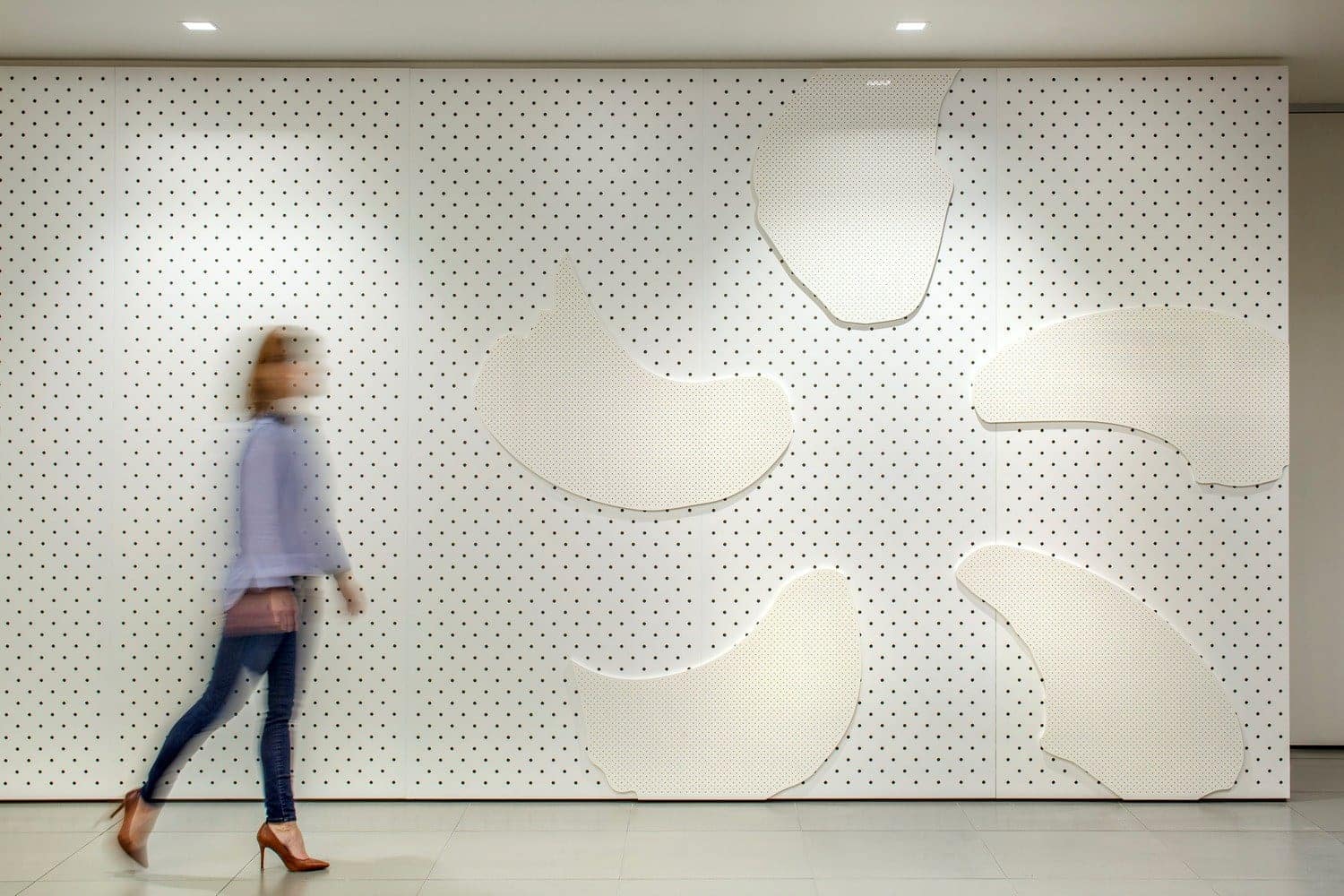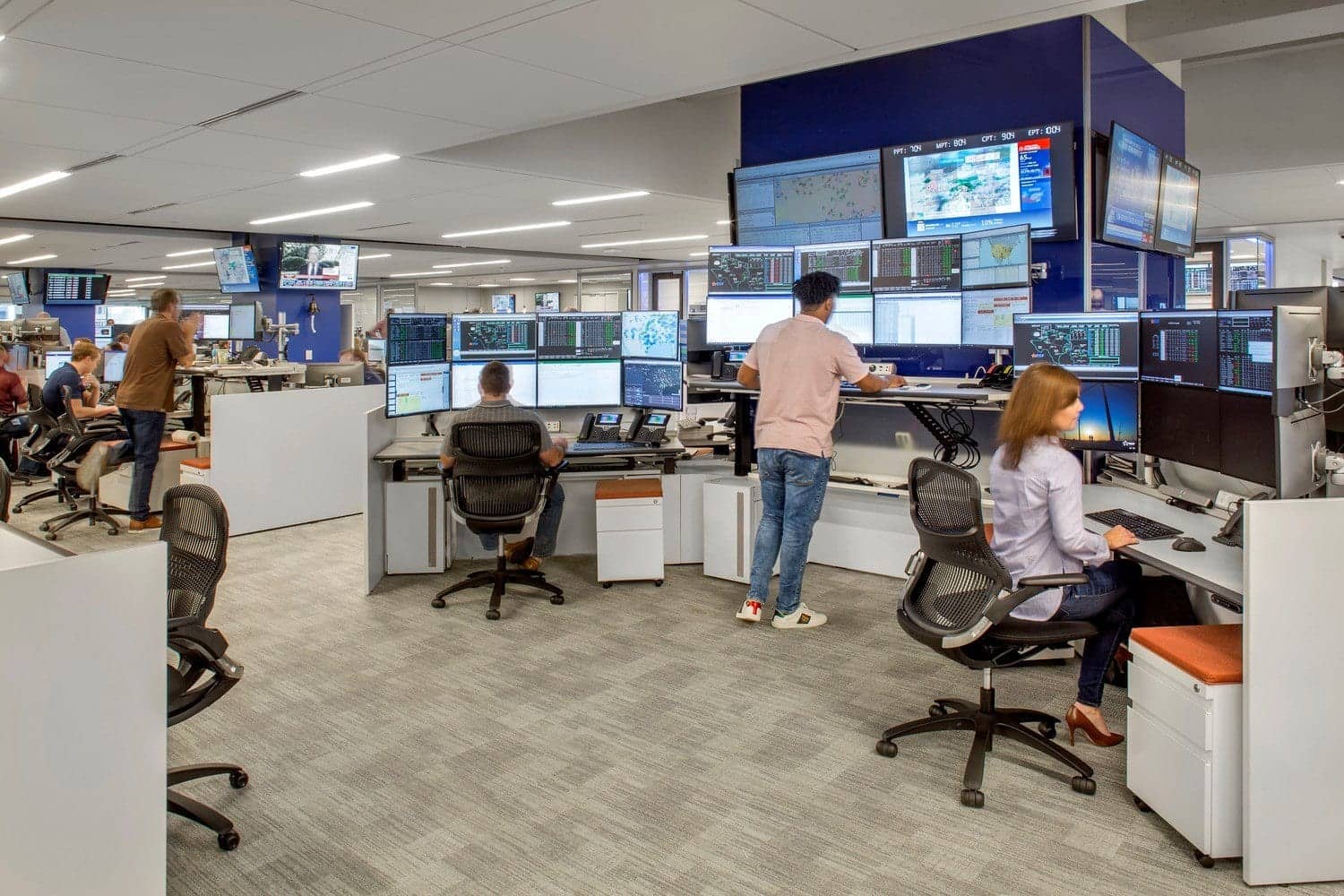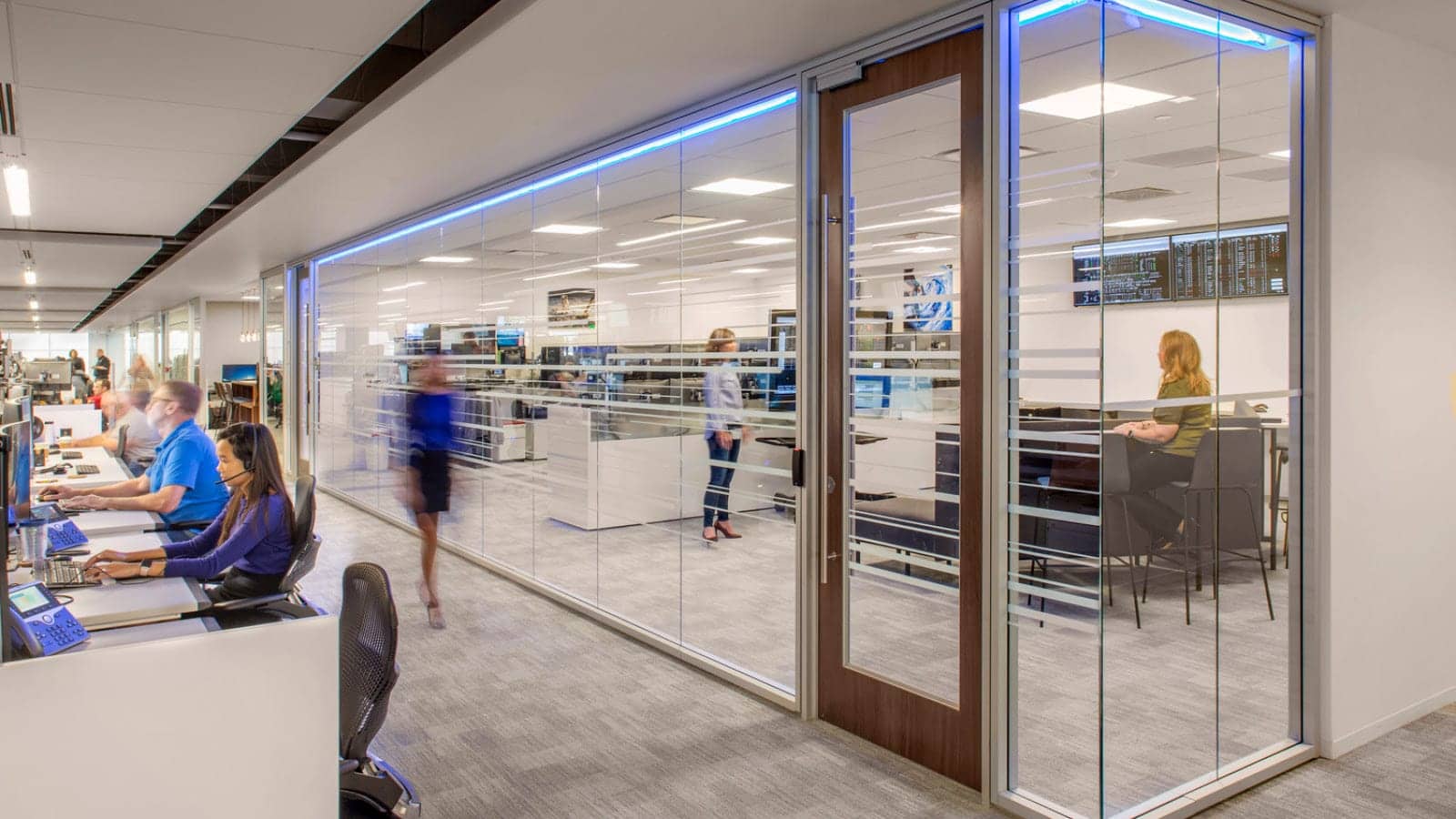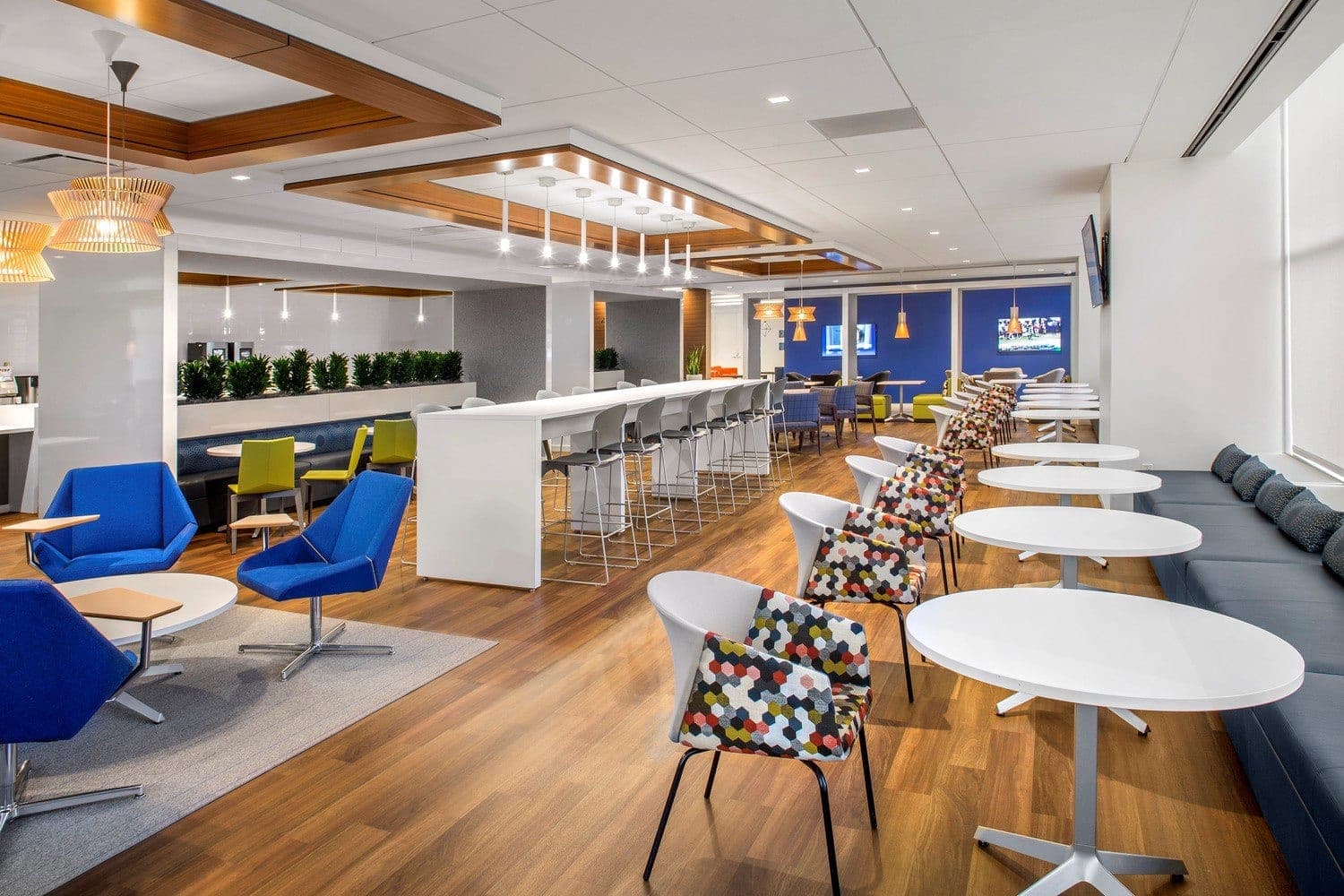By Ray Ehscheid | Director of Client Services
&
Nuno Moreira | Design Director

A subtle rendering of its logo makes a stunning statement at the new North American headquarters of global energy trading company EDF Trading. EDF Trading North American Headquarters, Houston Photography © Thomas McConnell.
Innovation within financial services has grown exponentially in the last ten years, with both traditional providers and rival upstarts offering products that have pushed banking into new frontiers. Teams within companies comprising the sector, faced with challenges wrought by regulation and a tightening labor market, find themselves competing not only with each other, but with tech titans and digital startups for the human capital required for growth. Although the current political climate in the US is leading towards a softening of some regulatory hurdles for banks, the ability to draw and retain talent continues to be a challenge for many firms globally.
Background
Across the spectrum of financial services, we at IA have seen an emphasis on significant change in modernizing the real estate footprint, both in client and non-client facing settings. The strategically designed environments resulting from that drive serve a multifold purpose to create dynamic new engagement spaces for attraction and retention of talent while economizing square footage in costly urban markets. Even the most traditional of institutions are pushing to eliminate isolated, largely empty office floors in favor of newly minted hospitality-infused spaces that blur lush, layered materials in lounge-like configurations with on-site barista bars and co-working spaces set amidst multiple collaboration area options. The workplace has become a driver for differentiation and a tool for retention to financial service providers, yielding multiple benefits amongst a myriad of work mode choices.
Trading Floors
Although there has been considerable new strategic direction in workplace design, the trading floor has remained a bulwark against the forces of modernization. Traders are still largely tied to their desks where hard-wired phones record their conversations and digital monitors track their progression through the web to ensure compliance needs are met. IA has worked with several firms to crack this wall, and we believe teams both large and small will see the benefits these efforts make in easing some challenges associated with this stressful role.
Movement has been progressive in adapting the environments in which these associates work to comply with new baselines and provide improved flexibility. Within many trading floors, ceiling heights have risen, and access to daylight has become almost universally standard. Food services have moved inboard from perimeter positions or from other floors to be proximate to trader desks and choices have become more varied and healthy. Huddle and morning meeting rooms have expanded to become multi-function, and on-floor offices have become universal in size and may be used as or converted to meeting spaces.
Technology has made enormous strides, and the pastiche of monitors once facing an associate has become more streamlined with fewer yet more configurable screens. Monitors themselves are anchored to desks that are height-adjustable, allowing traders to customize their work areas and avoid the health challenges commonly associated with all-day seated positions. CPUs have become smaller and more efficient, reducing by their sheer size and efficiency the heat loads prevalent across trading floors, while improvements in cooling distribution virtually eliminate dispersion issues.
The practice of maximizing density continues, with some firms reducing desk widths to a minimum 48-inch span while keeping standard 30-inch depths (although floating mounts provide associates some space below the monitors to compensate for the reduction in desk width). To break the sea of rows of traders, a few firms are experimenting with unusual physical layouts, incorporating 180-degree arcs or intriguing custom trapezoids. These spaces silently create more teaming options and give traders a view they have never had before of their colleagues and leaders.

An arc of trading desks breaks up the traditional sea of trading desks. EDF Trading North American Headquarters, Houston. Photography © Thomas McConnell.
What is Next?
We’ve focused our strategic eye on the trading floor, and as our teams have worked with some of the largest financial service providers in the global industry, our experience and knowledge drive us towards identifying five key levers we see as changing the way the industry looks at the trading floor experience.
Technology
As technology presses forward, the most natural move would be to further unburden traders by untethering them from fixed locations on the trading floor. Most financial service providers have focused technology on finding solutions that comply with their unique risk profile and thus positively impact information security. Utilizing cloud-based computing to maintain and manage access to such data through the use of thin client technology has been greatly successful and opened the possibility of allowing associates more workspace choice. Making the leap to such technology on the trading floor lets traders engage with their spaces differently, enabling teams to work side by side and groups to ebb and flow as program or project needs demand. Technology that allows tracking and recording tied to biometric identification, along with the obvious value to a firm of eliminating the expense associated with moving teams, could also possibly maintain compliance requirements and moderate collusion risk.
Artificial Intelligence continues to make inroads in banking, with on-screen digital assists working to better client relations with institutions via engaging avatars or simply by easing the transaction anxiety prevalent in some sectors of the populations. These tools have shown to make most transactions easier or at least more intuitive for both traders and clients throughout their engagements.
Some institutions will benefit from control-room type projects, for example a SCADA room, like those we have installed for clients utilizing a one-to-many approach where one associate can control multiple terminals via automated, intuitive systems. We posit a short leap towards adapting such practices to trading, building upon the algorithms in place today to both meet needs and expand the scope of trading activity. This may lead to fewer trading roles in some firms, smaller trading-floors in others, or to freeing up space in larger organizations for alternate purposes like embedding support teams or amenities.

EDF’s new offices includes a secure SCADA area. EDF North American Headquarters, Houston. Photography © Thomas McConnell.
Business Environments
The regulatory environment is poised for easing in the United States, but it equally may push to stricter rules as the political environment shifts. Global uncertainty is highlighted by the Brexit debate and by the shifting perception of a slowing Chinese market growth. This volatility is a key factor for our financial services clients as teams and technology must rapidly shift to ensure compliance to minimize a firm’s risk exposure, isolating or opening teams as regulation allows. Building in flexibility for physical space is essential, and many companies respond positively to various aspects of future proofing space. Established means of adaptability, including raised floors and demountable partitions, are gaining traction as manufacturers further improve each tactic. Shorter height-raised floors eliminate the echoes of footsteps and torque on stanchions, while higher STC ratings for demountable partition systems eliminate some hard construction requirements for sound dampening. Planning tactics like anticipating minimum widths between desking configurations and aisle allowances provide for rapid deployment of new barriers for isolation of business units if needed.
Ensuring isolation of traders from other teams is essential for most firms, yet the power portrayed in trader arrays is essential as a demonstration of a financial service provider’s prowess. Creating intentional tour paths has become a tactic deployed in many instances where information security would ordinarily prohibit such interactions. These intentional flows ensure that a display of how data may be harvested and used is revealed to tour participants in a showcased manner, with screens and views carefully controlled to achieve the dual purpose of positive impressions and risk minimization. Clients are using data and leveraging new technologies to exhibit financial innovation to clients (as well as internally) and to create specific areas to enhance the digital experience and celebrate the firm’s culture.
People
As within non-trading work floors, we see a continued benefit in exposing trading environments to a balanced mix of working configurations and amenities that encourage collective use behaviors and, ideally, idea generation. Co-working design influences initiated by the high-tech industry, have emerged strongly here, with focal points driven to link work and respite behaviors. High-top tables, moveable chairs, and lounge spaces can be placed amid or adjacent to trader neighborhoods to encourage breaking away, while food service options adjacent to many of these spaces immediately prompt collaborative engagement, whether work or socially driven. A quick break to refuel, enhanced by a conversation with a colleague, may engage a knowledge share resulting in a work effort breakthrough or simply a moment to step away and de-stress.

A wide selection of settings from collaboration areas to a robust cafe provide choice for traders. EDF North American Headquarters, Houston. Photography © Thomas McConnell.
Likewise, we have seen growth in embedding non-trading teams into trading environments where one team effectively supports the other. Developers, analysts, and programmers may benefit from continued exposure to their primary clients that may lead to innovations and result in products or services to benefit the traders. Building upon the spaces available and intervening amenity environments to embed these teams and encourage interactions will result in positive growth within the institution.
Wellness
As noted, strides have been made to include wellness elements among trading groups; sit-to-stand desking has become commonplace as has exposure to natural light. Collaborative style aesthetics achieved through furniture placement encourages movement throughout a space, and a lounge style seating area adjacent to a team offers a quick break away from the desk while maintaining line of sight. But what further?
We continue to see a growth in localized controls for traders. For example, environmental control elements may each have a localized output tailored to the user via under-floor heating and cooling governed by an app or a manual interface. As ways to nurture a healthier, valued staff, firms are fine-tuning a range of wellness amenities from providing on-staff ergonomists to yoga studios and self-coaching prompts on a user screen that encourage an associate to engage in a physical activity.
The growth in focus on this area is also partially driven by an emphasis on retention. The myriad of amenities afforded associates in high-tech firms must be countered by options provided within the context of trading environments. Small touches or large movements each embrace and enhance the experience. Coffee bars and honesty-type markets are becoming commonplace in offering traders positive environments while keeping them within close proximity to their desks.
Plants may be forbidden at trader desks, but green walls in common spaces can add life. Clients may or may not want live plants to enhance their space but all will benefit from biophilic graphic elements, a proven way to infuse nature into the trading environment.
This intriguing emphasis on elements that are more akin to hospitality-driven spaces emphasizes the blur we continue to see across different types of environments. Whether retail, foodservice, workplace or experiential, our design leaders continue to focus on enhancing each client’s brand and the human experience in the workplace.
Brand
The experience of branded spaces continues to elicit powerful reactions in both associates and leadership across the industry. We posit that it is both possible and desirable to empower spaces with a branded identity that, if desired, can be almost logo free. The ethos of the organization is the message we seek to capture that has the most resonance with the associates of a team. Becoming engaged with the brand drives a deeper connection within groups that connects them to the organization’s mission and culture. Many firms no longer focus primarily on logo and mission statement as a way to brand the workplace, but strive to incorporate the organization’s ethos into the space design with an emphasis on how staff works, their needs, and wellbeing. Tones, materials, sounds, and even smells are all aligned towards a deepening of the brand experience for engaged associates.
Conclusion
Many of these efforts in combination achieve several desirable results: attracting new talent, engaging existing talent, providing flexibility, anticipating and planning for future requirements, and reducing associate churn for operational and real estate efficiency. Reducing headcount via AI platforms and maximizing density frees space for amenity-rich environments. Feedback gained on various efforts reveals that trading teams seem to easily forgive dense environments when benefits are gained, and will work to recoup the upfront costs and defray potential long-term costs in favor of increased development and productivity or the reduction of square footage required for the business.
Most financial service organizations continue to look to peer firms as bellwethers to determine how far to push certain associate groups into strikingly new spaces supported by advanced technology. Within the industry itself, many of the efforts we note are in nascent stages yet we anticipate they will be deployed rapidly. As a firm, we continue to seek dynamic solutions for problems driving across various industries and continue to test our clients by placing new solutions in front of them for classic challenges. These five levers, combined with the forward movement of the industry, will pull trading environments in a solid direction as they vie with high-tech companies for innovation and talent in the years ahead.


